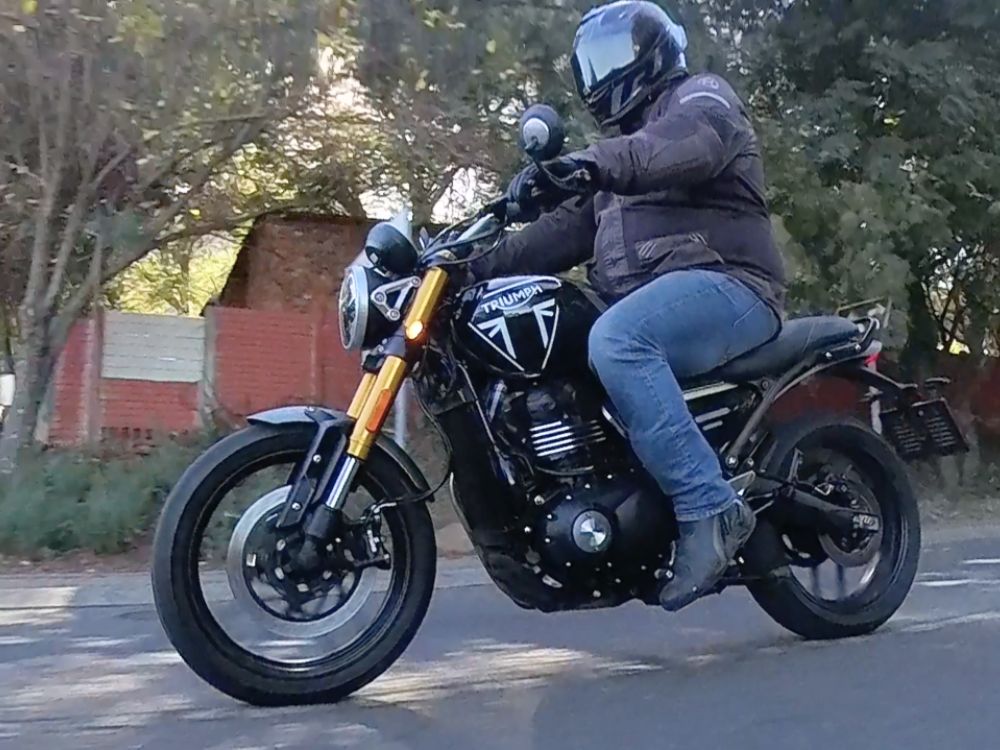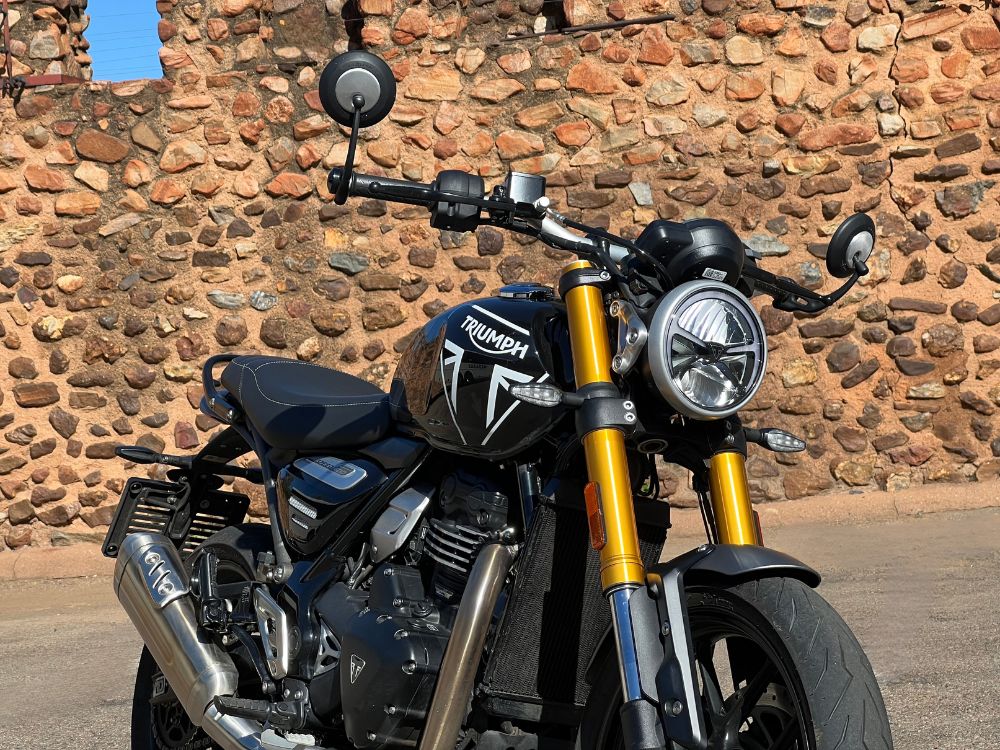Damn, this 400 class is picking up. Everyone is doing it – all four Japanese brands have something either in the 400cc class or very close to it, KTM has the 390, Husqvarna’s the Svartpilen 401, BMW has the 310, Harley-Davidson has the X440 in India, Ducati has the Scrambler 400 and Hero are going more international with the Maverick 440. All these models are fun, easy to ride and affordable which is good news. Then there is Triumph which is certainly not being left behind on this bandwagon, and it is not going to sacrifice any of its Triumph-ness doing so. May we present the Speed 400.
Glancing at the spec sheet shows a motorcycle that’s pretty much all there. The motor is a 398cc single that pushes a commendable 40 Hp and 38 Nm of torque. That’s in the ballpark. But if the Speed 400 really wanted to set the world on fire it would eclipse the 44 Hp of the also single-cylinder KTM 390. Its price is R100,000 that’s not bad when lined up next to the KTM’s R103,000, and a good chunk less than the BMW G310R’s R112,750.
It weighs 170 kg which also puts it right in the ballpark. Its suspension is not sophisticated with nothing really in the way of adjustability, but then none of the bikes in this class has that because sophisticated suspension would dump another R40,000 on top of the price tag making these machines silly.
It’s missing a fancy TFT screen like the KTM 390. In fact, the dash on the Speed 400 is somewhat odd. The speedo is a giant analogue dial that looks like a wonky Cyclops, and that’s odd because usually the rev counter is analogue and the speedo is digital. Next to the speedo is a small LCD screen with everything else in strange proportions. The gear indicator is huge as is the trip metre and other info section. The time is tiny and squashed between the trip metre and the fuel gauge. Then the rev counter is a tiny set of bars crammed between the gear indicator and everything else. We’ve often said that Triumph dash designers take vast amounts of psychedelic drugs before coming up with something wacky. With the Speed 400, they obviously had a dud batch.
So, so far the Speed 400 is proving itself to be somewhat mediocre. Not a great way to make your arrival in this competitive 400 class. But we are neglecting one small thing here. This bike is beautiful. No, really – this is a stunning machine. Every other entry to the 400 class, especially the Japanese and the Europeans, looks aggressive and somewhat ominous and much like a scary insect or some sort of robot. And that’s mostly from a distance – up close they are nice but you can see where they have made some measures to keep the costs down. Some components look like they’ve simply been taken off a shelf.
The Triumph Speed 400, on the other hand, looks like every other Triumph on the market – beautiful. The Speed 400 can park next to its bigger brethren in the Triumph showroom and hold its head up high. In fact, when the Speed 400 is parked in the showroom next to its bigger and pricier siblings, you’d be forgiven for walking straight past it thinking it’s simply one of the Triumph art pieces. I know this because it’s exactly what I did.
The front LED headlight is straight out of the classic Triumph stylebook with the gold forks contrasting beautifully with the dark exterior of the rest of the bike. The tank is classic teardrop-shaped with a traditional, offset flip fuel cap. The frame is again the classical black steel member with a black aluminium swing-arm, and the seat is a single unit that ends in a minimalistic tail-piece. The engine, as specified, is a single-cylinder unit with stylish cooling fins that are brushed on the ends to contrast with the matt black of the rest of the motor. These fins are mostly for style and keep the eye away from the black radiator hidden behind the frame. The exhaust is up-swept to really finish off a stylish outward appearance. Like all Triumphs, they have not skipped on the fine details like the unique shape of the mudguard, the panels, the bolt heads holding the casings on and pretty much everything else.
While the specs still might not set your world on fire, riding the Speed 400 is jolly good fun. The idling is an incongruous-to-this-class deep sonorous sound, and once you get moving, it becomes clear the Triumph has focused more on the journey to the redline rather than the redline itself. It climbs the rev counter from low down with grunt the whole way until the gearbox is smoothly called into action.
We saw a top speed of 170 km/h but 180 is probably doable. What’s more, it sits at 160km/h quite effortlessly even if it struggles to climb higher than that. The only downside is that, at 160, the motor is screaming somewhat as the rev-counter shudders in the upper echelons. This is fine except that at high rpm there’s a slight vibration through the bars.
When we first picked this bike up, wanting to test out its oomph and see what it could do, it was thought that this vibration would be a major deal, possibly even a deal-breaker. As we rode it more and more we found that its natural habitat is more at cruise speed taking advantage of the grunt at lower revs. It can go quickly but it’s more fun in a higher gear at lower revs.

While cruising and taking in the sights, you might notice that the bars are where most retro machines set them – higher up and wide enough to not put any strain on the wrists, arms, shoulders, back and bank account after receiving the chiropractor bill. The suspension, while not top-shelf MotoGP stock, is plenty comfortable enough to handle the bigger bumps without getting wobbly during spirited riding. At the same time, the classically styled seat is also classically wide and comfortable while the footpegs are low giving plenty of legroom.
The entire bike is quite low making a low centre of gravity that of course compliments an agile ride, great for tight roads or tight traffic. More so, there are indents in the front of the tank to give the forks room for a greater turning circle. With that, it can U-turn in less than its own length. And with a seat height of just 790mm, it means you are unlikely to lose your footing while doing so.
So here we have a motorcycle with a mediocre spec sheet proving once again that spec sheets need not be the ‘be-all and end-all’ of all motorcycling decisions. It’s a good-looking bike, not just for a 400 but anywhere in the biking kingdom. It’s good fun, easy and comfortable to ride and R100,000 is really a good price for all of this.
Quite frankly, Triumph is showing off a bit.
At your local Triumph dealer…

























